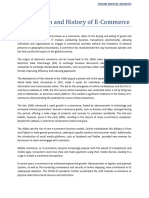Chapter 1: Introduction to E-Commerce Technology Infrastructure
1.1 Definition of E-Commerce
E-commerce, or electronic commerce, refers to the process of buying and selling goods and
services over the internet. It involves various types of transactions that take place in a digital
environment, allowing businesses, individuals, and governments to engage in commercial activities
online. The e-commerce ecosystem covers a wide array of business models, technologies, and
systems that enable these transactions to occur efficiently, securely, and at scale.
The fundamental principle of e-commerce is the same as traditional commerce – the exchange of
goods and services for money. However, the key difference is that e-commerce eliminates the need
for a physical storefront, offering a more accessible and efficient way to reach a global market. E-
commerce transactions can happen 24/7, offering consumers the convenience of shopping from
the comfort of their homes or on the go.
�1.2 Evolution of E-Commerce Platforms
The evolution of e-commerce platforms has been shaped by technological advancements, the
expansion of the internet, and shifts in consumer behavior. Over the past few decades, e-
commerce has transformed from basic websites to fully integrated digital ecosystems that offer a
range of services and customer experiences.
Early Stages (1990s): The 1990s marked the inception of e-commerce, with companies like Amazon
and eBay pioneering the online marketplace. The first online transactions were rudimentary,
limited to simple catalogs and basic payment systems. The most significant innovation during this
period was the development of Secure Sockets Layer (SSL) encryption, which enabled secure
payment processing and helped build consumer trust. Early e-commerce sites were simple, often
text-heavy, and lacked advanced functionalities like user reviews or product recommendations.
In the early stages, consumer skepticism about the safety and reliability of online transactions was
a significant barrier to widespread adoption. The introduction of PayPal in the late 1990s provided
a solution for secure online payments, and SSL encryption further helped reassure consumers.
Growth and Diversification (2000s): The 2000s witnessed a rapid expansion of e-commerce, driven
by increased internet connectivity, the proliferation of broadband, and more sophisticated website
technologies. Amazon, which began as an online bookstore, expanded into a marketplace for a
variety of consumer goods. eBay grew into a dominant auction-based platform, while new
platforms and services began to emerge in niche markets.
During this period, SEO (Search Engine Optimization) became an essential tool for driving traffic to
e-commerce sites, and businesses began to rely more heavily on online advertising through
services like Google AdWords. The introduction of e-commerce platforms like Shopify and Magento
enabled businesses of all sizes to create their own online stores without requiring extensive
technical knowledge. Websites also began to include more advanced features, such as product
reviews, customer support chat functions, and personalized shopping recommendations.
The rise of online payment solutions such as Stripe, and the increasing reliance on credit cards for
online transactions, marked a significant shift in how businesses approached e-commerce.
�Mobile and Social Integration (2010s): The 2010s saw the mobile revolution, as smartphones and
tablets became the primary devices for accessing the internet. E-commerce platforms adapted by
introducing mobile-responsive designs and dedicated mobile apps. Mobile commerce (m-
commerce) took off, with more consumers making purchases via their smartphones. Payment
solutions like Apple Pay, Google Wallet, and other mobile wallets became popular, allowing
consumers to make payments with a few taps on their phones.
Social media also began to play a crucial role in e-commerce. Facebook, Instagram, and Pinterest
became not only platforms for social interaction but also for commerce. Social commerce allowed
businesses to market and sell products directly through these platforms, with integrated payment
systems and features like Instagram Shopping and Facebook Marketplace.
Subscription-based services also gained momentum during this period, as companies like Birchbox,
Blue Apron, and Dollar Shave Club capitalized on the desire for convenience and personalization.
Subscription box models offered curated products delivered on a regular basis, tailored to
consumer preferences.
Omnichannel and Advanced Technologies (2020s): The 2020s ushered in a new phase in e-
commerce: omnichannel retailing. Retailers began to integrate online and offline experiences to
create a seamless shopping experience. Companies like Target and Walmart allowed customers to
purchase products online and either have them delivered to their homes or pick them up in-store.
The rise of smart speakers like Amazon Echo and Google Home also introduced the concept of
voice commerce, where consumers could make purchases using voice commands.
Augmented reality (AR) and virtual reality (VR) began to be integrated into e-commerce, enabling
consumers to "try on" clothes or visualize furniture in their homes before purchasing. AI and
machine learning became central to the user experience, offering personalized product
recommendations, real-time inventory updates, and tailored marketing.
�1.3 Key Components of E-Commerce Infrastructure
To support the seamless functioning of e-commerce platforms, several critical infrastructure
components are necessary. These components ensure that online transactions are smooth, secure,
and efficient, and they help businesses optimize their operations and provide better customer
experiences.
Web hosting Services
A robust web hosting solution is crucial for ensuring that an e-commerce platform remains
accessible, even during peak traffic times. Cloud computing platforms like Amazon Web Services
(AWS), Microsoft Azure, and Google Cloud provide the scalability and flexibility needed to handle
high volumes of data and customer traffic. These platforms also offer enhanced security, reliability,
and speed.
Content Delivery Networks (CDNs), such as Cloudflare, are another essential part of e-commerce
infrastructure. CDNs distribute website content across multiple servers located in different
geographical regions, improving load times and minimizing latency. This helps e-commerce sites
perform well for customers worldwide, even during periods of heavy traffic.
Website/Platform
E-commerce platforms like Shopify, Magento, and WooCommerce have simplified the process of
creating and managing online stores. These platforms often come with integrated tools for product
management, order processing, customer relationship management (CRM), and marketing.
Businesses can manage their e-commerce websites without needing to write complex code or hire
web developers for every change.
Modern e-commerce platforms also offer features like personalized product recommendations,
real-time inventory updates, and integration with third-party marketing and advertising platforms.
The focus on user experience (UX) design is paramount, as businesses must ensure that their
websites are intuitive, visually appealing, and easy to navigate to reduce bounce rates and increase
conversions.
�Payment Gateways
Payment processing is one of the most critical components of any e-commerce platform. E-
commerce websites need secure payment gateways to ensure that financial transactions are
completed smoothly and securely. Payment processors like PayPal, Stripe, and Square provide the
infrastructure to accept various forms of payment, including credit and debit cards, mobile wallets,
and alternative payment methods such as cryptocurrency.
Many e-commerce platforms integrate multiple payment options, offering customers flexibility in
how they pay for their purchases. This is especially important as consumers increasingly prefer the
convenience of services like Buy Now, Pay Later (BNPL), which allows them to make purchases and
pay in installments.
Inventory Management Systems
Effective inventory management is key to maintaining smooth e-commerce operations. Inventory
management systems (IMS) help businesses track stock levels in real time, allowing for more
accurate demand forecasting and better supply chain management. Systems like TradeGecko and
NetSuite offer sophisticated tools to manage inventory, monitor sales trends, and optimize
reordering processes.
Advanced IMS platforms integrate with e-commerce websites to automatically update product
availability, preventing overselling or stockouts. These systems also provide insights into which
products are popular, which helps businesses make informed decisions about product offerings
and marketing strategies.
Logistics and Fulfillment
Fulfillment involves the process of storing, packaging, and shipping products to customers. E-
commerce businesses often work with third-party logistics (3PL) providers, such as FedEx, UPS, or
DHL, to manage shipping and delivery. Many e-commerce companies also use fulfillment centers
that are strategically located to reduce shipping times and costs.
�In recent years, many e-commerce businesses have adopted micro-fulfillment centers, which are
smaller warehouses located closer to urban areas. These centers enable faster delivery and lower
shipping costs, especially for same-day or next-day delivery services.
Customer Support
Effective customer support is crucial for maintaining customer satisfaction and loyalty. Many e-
commerce platforms integrate AI-driven chatbots that can handle basic customer inquiries and
provide instant responses. These chatbots can assist with order status, returns, and basic product
information.
Additionally, more complex issues are handled by live support agents, often through phone or
email. Customer Relationship Management (CRM) systems help businesses track interactions with
customers, ensuring that customer support teams have all relevant information at their fingertips
to provide personalized and efficient service.
�1.4 Types of E-Commerce Models (B2B, B2C, C2C, etc.)
The e-commerce industry encompasses a wide variety of business models that cater to different
types of participants. These models differ based on the parties involved, the nature of the
transaction, and the value proposition offered by the platform. Some of the key models include:
Business-to-Business (B2B)
B2B e-commerce involves transactions between businesses. This model is often seen in industries
where large quantities of goods or services are exchanged. Companies such as Alibaba, Amazon
Business, and ThomasNet serve as marketplaces for businesses to purchase products in bulk,
typically at wholesale prices. This model also includes procurement platforms that allow
companies to source materials or services from other businesses.
Business-to-Consumer (B2C)
B2C is the most widely known e-commerce model, where businesses sell products directly to
individual consumers. Amazon, Walmart, and Best Buy are examples of B2C e-commerce giants.
This model emphasizes a streamlined shopping experience, with businesses offering a wide range
of consumer goods, flexible payment options, and fast shipping services.
Consumer-to-Consumer (C2C)
C2C e-commerce allows individuals to sell products directly to other individuals. Platforms such as
eBay, Craigslist, and Poshmark enable consumers to list their items for sale, either as second-hand
goods or new products made by independent sellers. C2C models usually involve less formal
processes than B2B or B2C transactions, with platforms acting as intermediaries to facilitate
payments and shipping.
Consumer-to-Business (C2B)
In this model, consumers offer products or services to businesses. Freelance work is a key example
of C2B, where individuals offer their skills (such as web development, graphic design, or writing)
to businesses in need. Platforms such as Fiverr, Upwork, and Freelancer.com enable C2B
�transactions. This model empowers individuals to set their own prices and work schedules while
giving businesses access to a wide range of skills and expertise.
Business-to-Business-to-Consumer (B2B2C)
B2B2C is a hybrid model that involves businesses selling to other businesses that, in turn, sell
directly to consumers. This model is commonly seen in supply chain relationships where
manufacturers sell products to retailers who then sell them to end consumers. A good example of
this is Shopify, where businesses can build their own online stores and directly sell products to
consumers, but Shopify serves as the intermediary platform.
�1.5 Importance of E-Commerce
E-commerce has rapidly become a cornerstone of the global economy, revolutionizing how
businesses operate, consumers shop, and how goods and services are exchanged across the globe.
Its importance extends beyond simply providing a platform for buying and selling products. The
growth of e-commerce has reshaped industries, enabled access to new markets, and empowered
both consumers and businesses in unprecedented ways. Below are some of the key reasons why
e-commerce is crucial in today’s world:
1.5.1 Expanded Market Reach and Global Accessibility
One of the most significant benefits of e-commerce is the ability to reach a global audience.
Traditional brick-and-mortar stores are limited by geography, as they are only accessible to people
within a specific location. In contrast, an e-commerce website can cater to customers across the
world, enabling businesses to expand their reach beyond local boundaries. This global accessibility
breaks down traditional barriers and opens up opportunities for businesses to access new markets
and grow their customer base.
For consumers, e-commerce provides the opportunity to access products and services that may
not be available in their local stores. Whether it’s unique handmade goods from another country,
hard-to-find niche products, or services from global brands, e-commerce platforms make these
accessible with just a few clicks. This expanded market reach benefits both businesses looking for
new opportunities and consumers who want variety and convenience.
�1.5.2 Convenience and Time Savings
E-commerce provides consumers with unmatched convenience. Online shopping enables
customers to browse, compare, and purchase products or services at any time of day or night,
without the need to visit physical stores. This 24/7 availability aligns with the modern consumer’s
lifestyle, making it easier for them to shop on their own time and at their own pace.
For businesses, the ability to operate around the clock means they can generate revenue at all
times. E-commerce platforms handle transactions and process orders automatically, without
requiring staff to be available at all hours. This results in a significant time-saving advantage for
both businesses and customers.
E-commerce also offers the added convenience of delivering products directly to customers' doors,
removing the need to visit stores physically. As more people prioritize convenience, especially in a
world that values speed and efficiency, e-commerce has become an essential service in modern
society.
�1.5.3 Cost Efficiency for Businesses
Operating an online store generally incurs fewer overhead costs compared to running a physical
retail operation. Traditional brick-and-mortar stores require substantial investments in real estate,
utilities, on-site staff, and other physical assets. In contrast, e-commerce businesses can operate
with lower initial investments. The ability to set up a store online without needing a physical
location means businesses can save on rent, utilities, and even staffing costs.
Additionally, digital marketing, such as social media ads, search engine optimization (SEO), and
email marketing, provides businesses with cost-effective ways to reach their target audience
compared to traditional advertising methods like TV or print ads. E-commerce platforms also allow
businesses to scale operations with ease, ensuring that their infrastructure grows proportionally
to their success.
For small and medium-sized businesses (SMBs), e-commerce offers an affordable way to reach a
global audience, level the playing field, and compete with larger enterprises. Many e-commerce
platforms, such as Shopify, WooCommerce, and Etsy, provide affordable tools and resources to
help businesses get started without a significant upfront investment.
�1.5.4 Personalized Shopping Experience
One of the advantages of e-commerce is the ability to offer personalized shopping experiences to
customers. E-commerce platforms collect data on consumer behaviors, preferences, and purchase
history, allowing businesses to tailor their offerings to individual customers. Personalized
recommendations, product suggestions, and targeted advertisements enhance the shopping
experience by showing customers products they are more likely to be interested in.
For example, Amazon uses algorithms to recommend products based on customers' browsing
history, previous purchases, and preferences. This type of personalization creates a more engaging
and relevant shopping experience, which can increase customer satisfaction and loyalty.
Consumers appreciate this level of personalization because it saves them time, reduces search
frustration, and enhances their overall shopping experience.
1.5.5 Streamlined Inventory and Order Management
E-commerce allows businesses to automate and streamline many of their internal processes, such
as inventory management, order fulfillment, and customer service. With e-commerce platforms
integrated with inventory management systems, businesses can track their stock levels in real-
time, ensuring that they never run out of popular products or overstock on items that aren’t selling.
In addition, e-commerce platforms help businesses maintain efficient order management systems,
automating processes such as order confirmation, shipment tracking, and customer notifications.
This leads to faster order fulfillment, more accurate delivery times, and an overall better customer
experience. Businesses that leverage e-commerce can scale quickly, manage larger inventories,
and offer faster shipping and delivery times than ever before.
�1.5.6 Enhanced Customer Insights and Analytics
Another significant advantage of e-commerce is the wealth of data it generates. E-commerce
platforms provide valuable customer insights through analytics tools that allow businesses to
monitor consumer behavior, sales trends, and market dynamics. By tracking how customers
interact with their online store, businesses can make data-driven decisions to optimize their
product offerings, website design, and marketing strategies.
For example, data analytics can reveal which products are performing well, which marketing
campaigns are driving traffic, and how customer preferences are evolving. Armed with these
insights, businesses can improve their inventory management, enhance customer satisfaction, and
maximize profits. The ability to measure and analyze customer interactions is a powerful tool for
businesses to stay competitive in an ever-changing market.
1.5.7 Flexibility and Scalability
E-commerce offers unparalleled flexibility for businesses. Companies can launch, adjust, and adapt
their online stores with ease, making it possible to respond quickly to market demands or changes
in consumer behavior. With cloud-based e-commerce platforms, businesses can scale their
operations without worrying about physical infrastructure limitations.
As businesses grow, they can easily add new products, services, payment options, and even expand
into new markets. The scalability of e-commerce allows businesses to handle increased demand
and traffic without experiencing significant disruptions or additional capital expenditures.
�1.5.8 Reduced Environmental Impact
E-commerce has the potential to reduce the environmental impact associated with traditional
retail. Physical stores consume large amounts of energy for lighting, heating, and cooling, and the
transportation required to move products to stores contributes to carbon emissions. With e-
commerce, many of these environmental challenges can be mitigated.
E-commerce platforms, especially those utilizing digital marketing and cloud-based infrastructure,
have a lower carbon footprint compared to brick-and-mortar businesses. Additionally, consumers
who opt for home delivery instead of driving to a store can reduce their individual carbon
emissions, especially if products are delivered via optimized, consolidated shipping methods that
reduce the number of trips needed.
1.5.9 Competitive Advantage
In today’s fast-paced digital world, e-commerce offers businesses a clear competitive advantage.
Companies that are not online risk losing out to competitors that have established an online
presence. E-commerce allows businesses to keep pace with consumer expectations, offering the
convenience of online shopping, fast shipping, and personalized experiences that customers now
expect.
E-commerce also allows companies to adapt to emerging trends quickly. For example, during the
COVID-19 pandemic, businesses that had established online sales channels were able to pivot
quickly, offering curbside pickup or delivery options, while others that relied solely on physical
stores struggled to survive.
�1.5.10 Economic Growth and Job Creation
E-commerce plays an important role in driving economic growth. By enabling businesses to expand
their reach and increase sales, e-commerce contributes to GDP growth and increases the overall
competitiveness of the economy. Additionally, e-commerce has created millions of jobs in various
sectors, including technology, logistics, marketing, customer service, and supply chain
management.
The rise of e-commerce has led to the creation of new industries, such as digital marketing
agencies, web development firms, and third-party logistics providers. It has also empowered
entrepreneurs to start their own businesses, create new products, and provide services that they
may not have been able to offer through traditional means.
�Revision Questions
1. What are the key factors that make e-commerce technology infrastructure essential for the
success of modern online businesses?
2. How has the evolution of e-commerce platforms transformed the way businesses interact with
customers and manage transactions?
3. What are the primary components of e-commerce infrastructure, and how do they support
seamless online business operations?
4. How do B2B, B2C, and C2C e-commerce models differ in terms of business strategies and
target audiences?
5. What are the technological advancements that have led to the growth of e-commerce
platforms in recent years?
6. How do e-commerce platforms handle payment processing and ensure secure transactions for
customers and businesses?
7. How have cloud computing and hosting solutions impacted the scalability and flexibility of e-
commerce infrastructure?
8. What role does mobile commerce (m-commerce) play in the growth of e-commerce and
changing customer purchasing behaviors?
9. How does the integration of customer relationship management (CRM) systems enhance e-
commerce business operations and customer engagement?
10. How does an effective inventory management system support e-commerce platform in
handling large volumes of product data?
11. How have innovations in payment gateways, such as digital wallets and cryptocurrencies,
changed the way e-commerce platforms handle transactions and customer payments securely
and efficiently?
12. What are the significant differences between B2B and B2C e-commerce models in terms of
sales processes, customer interactions, and marketing strategies?
13. How do emerging technologies like artificial intelligence and machine learning enhance the
functionality of e-commerce platforms by personalizing customer experiences and optimizing
inventory management?
�14. How have advancements in internet security, such as encryption protocols and secure
payment gateways, ensured safe transactions and trust for customers shopping online?
15. What role do logistics and supply chain management play in the overall success of e-commerce
infrastructure, especially for handling large order volumes and ensuring timely delivery?
16. How does the use of APIs and third-party integrations improve the functionality of e-
commerce platforms by enabling seamless connections with payment providers, shipping
carriers, and other services?























































































